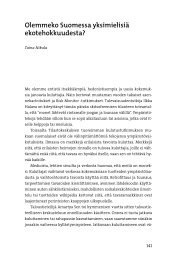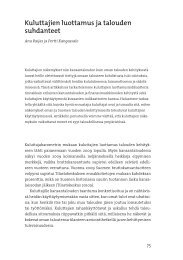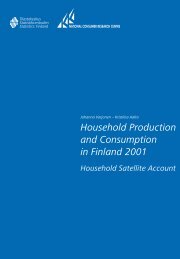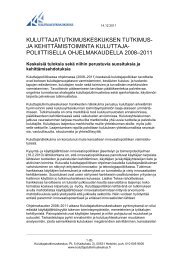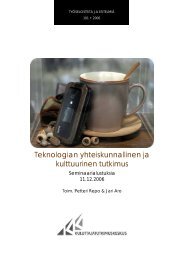Household Production and Consumption in Finland 2001
Household Production and Consumption in Finland 2001
Household Production and Consumption in Finland 2001
Create successful ePaper yourself
Turn your PDF publications into a flip-book with our unique Google optimized e-Paper software.
Non-SNA food<br />
The output of non-SNA meals production amounts to 23 billion, which is<br />
around 100 times more than SNA food. It <strong>in</strong>cludes provision of meals <strong>and</strong><br />
snacks <strong>in</strong> households.<br />
<strong>Consumption</strong> of fixed capital accounts for a much smaller proportion of<br />
non-SNA food than SNA food, no more than a couple of per cent. Although<br />
households use a wide range of household appliances as well as cookware <strong>and</strong><br />
serv<strong>in</strong>g dishes, these are relatively durable <strong>and</strong> consumption is therefore spread<br />
out across several years.<br />
The preparation of meals requires a large amount of <strong>in</strong>termediate<br />
consumption goods. One-quarter of household electricity consumption <strong>and</strong><br />
one-fifth of water consumption are allocated to the preparation of meals <strong>and</strong><br />
snacks (Appendix 8). For purchased foods it has been necessary to make a<br />
dist<strong>in</strong>ction between foods used as <strong>in</strong>gredients <strong>in</strong> meal preparation, on the one<br />
h<strong>and</strong>, <strong>and</strong> foods that are ready to eat, i.e. f<strong>in</strong>al consumption goods, on the<br />
other. The boundary l<strong>in</strong>e is not always watertight. In some households some<br />
products may be eaten as snacks without any process<strong>in</strong>g, <strong>in</strong> others they are<br />
used as <strong>in</strong>gredients <strong>in</strong> the preparation of meals. In the Satellite Account more<br />
than one-half of foods were def<strong>in</strong>ed as f<strong>in</strong>al consumption goods, which means<br />
that they can either be consumed as such as snacks, or they constitute a meal<br />
<strong>in</strong> their own right. However there are some foods that are both consumed as<br />
such <strong>and</strong> used as <strong>in</strong>gredients <strong>in</strong> production (e.g. milk, fruit). In the absence of<br />
detailed <strong>in</strong>formation, these foods are classified so that one food <strong>in</strong> the group<br />
has been chosen to represent one or the other category. For example, non-fat<br />
milk has been chosen to represent milk as a f<strong>in</strong>al consumption good, while<br />
other types of milk are classified as <strong>in</strong>termediate consumption goods. As for<br />
fruit, apples have been chosen to represent all the various fruits that are used<br />
<strong>in</strong> cook<strong>in</strong>g or bak<strong>in</strong>g as <strong>in</strong>termediate consumption goods, <strong>and</strong> other fruits<br />
represent f<strong>in</strong>al consumption goods. (See the list of foods <strong>and</strong> their allocation to<br />
<strong>in</strong>termediate <strong>and</strong> f<strong>in</strong>al consumption <strong>in</strong> Appendix 3).<br />
Figure 5.<br />
Value of meals <strong>and</strong> beverages by mode of production<br />
Eat<strong>in</strong>g out,<br />
ready-to-eat<br />
foods<br />
17%<br />
Meals, snacks <strong>and</strong> dr<strong>in</strong>ks,<br />
total 32.2 billion euros<br />
Alcoholic beverages<br />
11%<br />
Own production<br />
57%<br />
Shopp<strong>in</strong>g <strong>and</strong><br />
related travel<br />
15%<br />
National Consumer Research Centre Statistics F<strong>in</strong>l<strong>and</strong> 39




